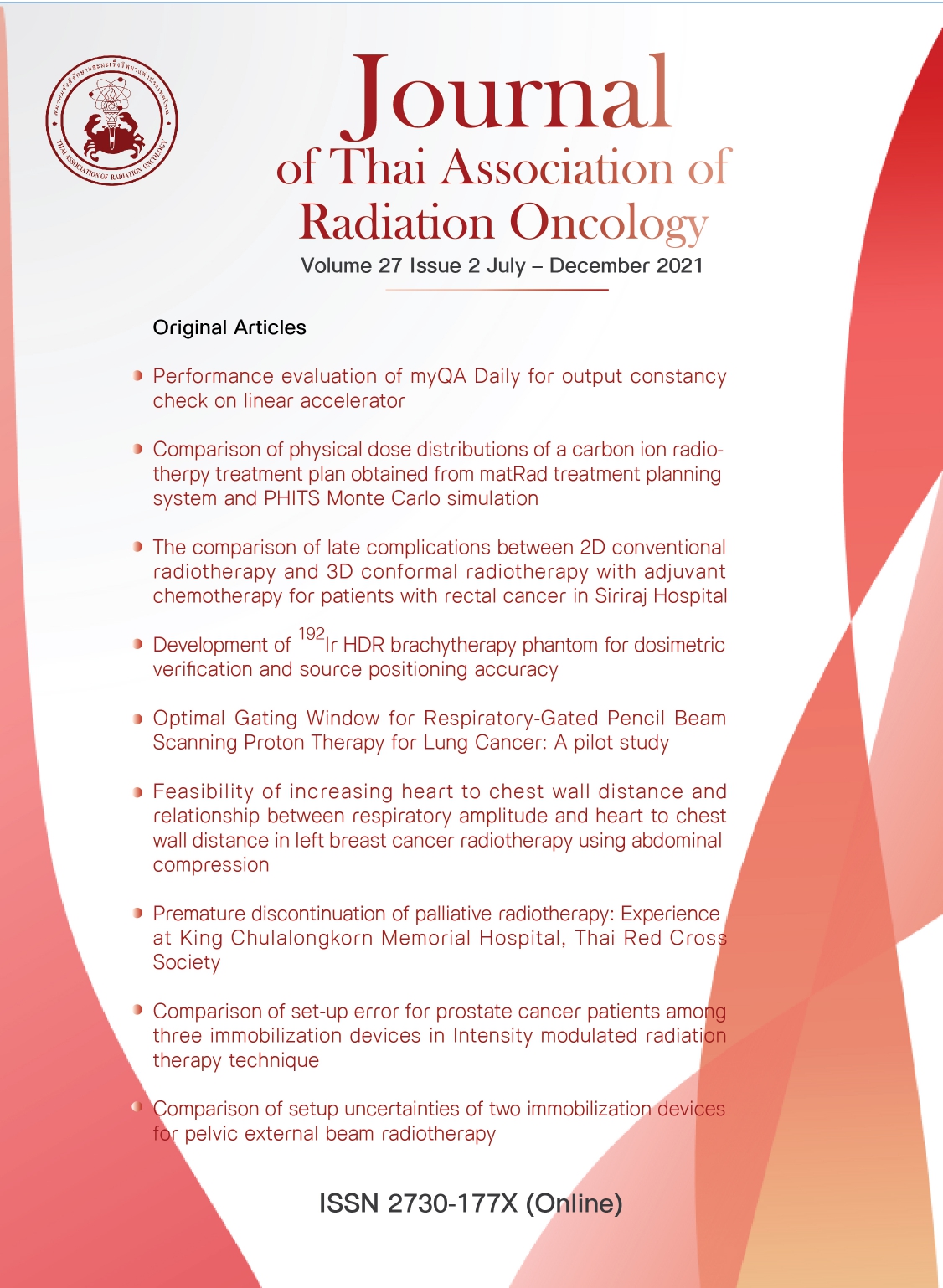Feasibility of increasing heart to chest wall distance and relationship between respiratory amplitude and heart to chest wall distance in left breast cancer radiotherapy using abdominal compression
Keywords:
Moderate deep inspiration breath hold, Heart to chest wall distance, Respiratory amplitude, Abdominal CompressionAbstract
Backgrounds: In radiotherapy for left sided breast cancer, the radiation dose to the heart and left anterior descending artery (LAD) are major concerns. There have been attempts to develop an effective and reproducible radiotherapy technique in order to minimize dose to the organ at risk.
Objectives: To investigate the use of the Abdominal Compression (AC) with moderate deep inspiration breath hold technique (mDIBH+AC) in left side breast cancer radiotherapy. The primary objective was to evaluate an increasing of the heart to chest wall distance by using mDIBH+AC along with the relationship between respiratory amplitude and the heart to chest wall distance. The secondary objective was to assess the radiation doses delivered to the heart and LAD and duration for breath hold technique.
Materials and methods: Eleven patients with left sided breast cancer were enrolled in our study. CT simulation was undergone and recorded respiratory signal with Anzai Belt system in 3 data sets: Free breath (FB), Deep inspiration breath hold (DIBH) and moderate deep inspiration breath hold with abdominal compression (mDIBH+AC). Respiratory signal was analyzed with Fourier Transform technique. Then, the heart to chest wall distance, the respiratory amplitude and radiation doses of the heart and LAD from the radiation treatment plans were evaluated. The time of breath hold was also compared between DIBH and mDIBH+AC.
Results: The average heart to chest wall distances were 0.46 ± 0.22, 0.99 ± 0.57 and 0.97± 0.54 cm for FB, DIBH and mDIBH+AC, respectively. We found a moderate positive correlation between respiratory amplitude and the heart to chest wall distance with a statistically significant Pearson correlation coefficient of 0.623. Using mDIBH+AC reduced Dmean, Dmax,V20Gy and V30Gy of the heart by 5.40%, 5.39%, 23.02% and 28.14%, respectively, and Dmean, Dmax and D2% on LAD by 13.77%, 6.59% and 7.16%, respectively when compared with FB. Moreover, the duration of breath hold in mDIBH+AC was longer than DIBH in most patients, increased from 28.52±6.54 sec to 31.13±8.35 sec (p=0.122).
Conclusions: Using of AC is effective to increase the heart to chest wall distance including reducing radiation dose to the heart and LAD compared with FB. Moreover, AC showed improving stability of mDIBH.
References
Desai N, Currey A, Kelly T, Bergom C. Nationwide trends in heart-sparing techniques utilized in radiation therapy for breast cancer. Adv Radiat Oncol. 2019;4:246-252.
Bergom C, Currey A, Desai N, Tai A, Strauss JB. Deep inspiration breath hold: techniques and advantages for cardiac sparing during breast cancer irradiation. Front Oncol. 2018;8:1-10.
Darby SC, Ewertz M, McGale P, Bennet AM, Blom UB, Brønnum D, et al. Risk of ischemic heart disease in women after radiotherapy for breast cancer. N Engl J Med. 2013; 368:987-98.
Giraud P, Houle A. Respiratory gating for radiotherapy: Main technical aspects and clinical benefits. ISRN Pulmonology. 2013;1-14.
Ledsom D, Reilly AJ, Probst H. Assessment of deep inspiration breath hold (DIBH) amplitude and reduction in cardiac dose in left breast cancer patients. Radiography (Lond). 2017;1-6.
Keall PJ, Mageras GS, Balter JM, Emery RS, Forster KM, Jiang SB, et al. The management of respiratory motion in radiation oncology report of AAPM Task Group 76. Med Phys. 2006; 33: 3874-3900.
Patient Immobilization and Image Guidance. In: Metcalfe P, Kron T, Hoban P, editors. The physics of radiotherapy x-rays and electrons. [Internet]. [cited 2020 Mar 10]. Available from:
https://medical physics.org/documents/MetcalfeCh12.pdf
Wunderink W, Romero AM, Kruijf WD, Boer HD, Levendag P, Heijmen B. Reduction of respiratory liver tumor motion by abdominal compression in stereotactic body frame analyzed by tracking fiducial markers implanted in liver. Int J Radiat Oncol Biol Phys. 2008;71:907-915.
Snider JW, Molitoris J, Zhang B, Chuong MD. Abdominal Compression During Liver Stereotactic Body Radiation Therapy (SBRT) by Volumetric Modulated Arc Therapy (VMAT) Affords Significant Liver Sparing. Int J Radiat Oncol Biol Phys. 2015;93:S116-117.
Register S, Takita C, Reis I, Zhao W, Amestory W, Wright J. Deep inspiration breath hold technique for left sided breast cancer: An analysis of predictor for organ at risk sparing. Med Dosim. 2015; 40:89-95.
Singh AD. The implementation & evaluation of four-dimensional computed tomography in lung radiotherapy [Master’s thesis]. Swansea: Swansea university; 2013.
Sager O, Beyzadeoglu M, Dincoglan F, Oysul K, Kahya YE, Gamsiz H, et al. The role of active breathing control-moderate deep inspiration breath hold (ABC-mDIBH) usage in non-mastectomized left sided breast cancer radiotherapy: a dosimetric evaluation. Int J Hematol. 2012;22:147-155.
Chu KY, Cooke R, Heuvel FV, Mukherjee S , Hawkins MA. Impact of abdominal compression on setup error and image matching during radical abdominal radiotherapy. Tech Innov Patient Support Radiat Oncol. 2019;12:28-33.
Qi XS, White J, Rabinovitch R, Merrell K, Sood A, Bauer A, et al. Respiratory organ motion and dosimetric impact on breast and nodal irradiation. Int J Radiat Oncol Biol Phys. 2010;78:609-617.
Wang W, Li JB, Hu HG, Li FX, Xu M, Sun T, et al. Correlation between target motion and the dosimetric variance of breast and organ at risk during whole breast radiotherapy using 4DCT. Radiat Oncol. 2013;8:1-6.
Downloads
Published
How to Cite
Issue
Section
License
บทความที่ได้รับการตีพิมพ์เป็นลิขสิทธิ์ของวารสารมะเร็งวิวัฒน์ ข้อความที่ปรากฏในบทความแต่ละเรื่องในวารสารวิชาการเล่มนี้เป็นความคิดเห็นส่วนตัวของผู้เขียนแต่ละท่านไม่เกี่ยวข้องกับ และบุคคลากรท่านอื่น ๆ ใน สมาคมฯ แต่อย่างใด ความรับผิดชอบองค์ประกอบทั้งหมดของบทความแต่ละเรื่องเป็นของผู้เขียนแต่ละท่าน หากมีความผิดพลาดใดๆ ผู้เขียนแต่ละท่านจะรับผิดชอบบทความของตนเองแต่ผู้เดียว




